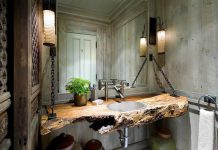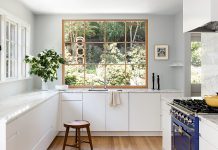Mencoret.com – If you are looking for a small industrial study room for your home, there are plenty of options. For instance, you can opt for a metal bed frame and a red brick accent wall. Another option is to have a floor-to-ceiling window. This will make the space feel a lot bigger and allow you to get more work done.
Gives a Minimalist Look with Style
In addition to the obvious use of a black iron bed frame, this metal frame also provides a minimalistic, modern, and sleek look. You may also want to add a touch of eclecticism. For instance, you could use LED festoon lights to drape around the metal framed bed and add some color to your decor. If you have an industrial or rustic-style room, a black iron bed frame is a perfect choice. You can choose from a range of styles and price ranges. The best part is that this type of frame will open up the space and provide plenty of storage space.
Zinus’ industrial-style bed is made from a durable steel frame and comes with all the tools you need to assemble it. It features a headboard that is 47 inches tall and upholstered in navy fabric. There are also wooden slats to support your mattress. White walls are no doubt a given in any modern study room. This color scheme is complemented by a well-chosen selection of furniture. In particular, the white desk and chair pair up nicely with the white open ceiling. The wood-like materials used in the built-in cabinets are a nice touch.

While you’re at it, take a good look at the floor tiles. Not only are they visually interesting, they also add a little dynamism to the overall look. The color scheme is enhanced by an eye-catching floor-to-ceiling window. To make the most of the space, a long floating desk is set in a clever l-shape. A bookshelf is strategically placed to evaluate the unused corner between the windows.
Popular Brick Walls and Textured Appeal
The best part is that all this functionality and style comes with the price of a rent-free apartment. It’s no secret that brick walls are popular for both exterior and interior use. They add character, warmth, and a textured appeal. However, it can be tricky to choose the best option for your home.
Bricks are often associated with industrial-style decor. That’s why it’s important to think about how they’ll be incorporated into your design. There are many ways to do this. A classic red brick accent wall is a timeless feature that can be used in almost any room. From a bedroom to a living room, you can use it to complement your existing decor. You can even create a unique look by mixing a classic style with an eclectic flair.

Another way to incorporate brick is with a faux brick wall. While real bricks aren’t always easy to find or install, a faux version is simple and affordable. A floor-to-ceiling window is a great way to bring natural light into a room. It can be used to solve practical problems or just to enjoy the outdoors from the comfort of your home. For instance, a study area in the living room can be a nice touch for a modern household. The benefits are twofold: You get to enjoy the outdoors without having to leave the house and your interiors look more contemporary.
Utilizing Its Unique Properties in Decoration Schemes
Floor-to-ceiling windows are also a great way to maximize the functionality of your home’s space. For instance, you can place a desk in an L-shaped layout and utilize the space to the fullest. Another way to make the most of your floor-to-ceiling window is to utilize its unique properties in your decorating scheme. For instance, you can add a wall of built-in recessed shelving to display your favorite books and collectibles. Biophilic design is the art and science of designing buildings and landscapes that enhance the health and well-being of people. In its simplest definition, it involves re-connecting people to their environment. These designs are designed to address a range of issues including thermal comfort, water management, and energy use.

The practice of biophilic design codifies human intuition, neural sciences, and the natural world. It also serves as a platform for addressing performance-based building challenges. For example, it can increase thermal comfort, reduce perceived noise pollution, improve acoustics, and decrease energy costs. Although many biological responses occur simultaneously with the design of a space, it is crucial that all interventions are in support of a unified design intent. A wide variety of approaches can meet the needs of different user groups.










